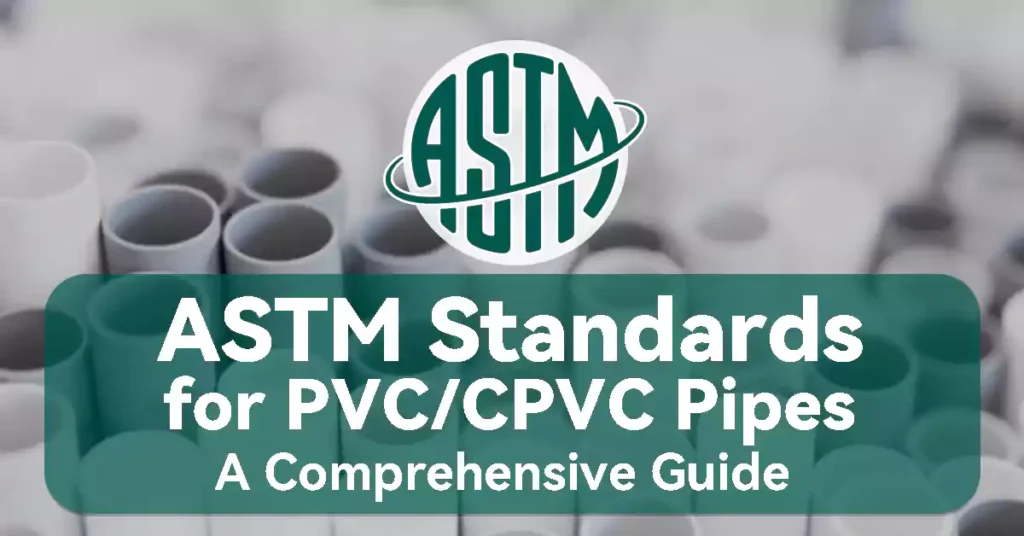
Inhaltsverzeichnis
Polyvinyl Chloride (PVC) and Chlorinated Polyvinyl Chloride (CPVC) pipes and conduits are widely used in various industries due to their durability, chemical resistance, and cost-effectiveness. To ensure the quality and performance of these materials, the American Society for Testing and Materials (ASTM) has established a series of standards. These standards are crucial for manufacturers, engineers, and contractors to adhere to industry best practices and regulatory requirements.
In this comprehensive guide, we will explore the key ASTM standards applicable to PVC and CPVC pipes and conduits, their significance, and how they contribute to the safety and efficiency of piping systems.
The American Society for Testing and Materials (ASTM), now known as ASTM International, is a globally recognized organization that develops and publishes voluntary consensus standards. Founded in 1898, ASTM’s mission is to improve product quality, enhance safety, and facilitate trade through the standardization of materials, products, systems, and services.
For PVC and CPVC pipes, ASTM standards cover aspects such as material composition, physical properties, performance criteria, and testing methodologies. These standards help ensure consistency, reliability, and compatibility across different applications and environments.
Several ASTM standards apply specifically to PVC and CPVC pipes. Understanding these standards is essential for engineers, contractors, and quality control personnel to select the appropriate piping materials for their projects. Some of the most commonly referenced ASTM standards include
ASTM D1784 – 20: Standard Classification System and Basis for Specification for Rigid Poly(Vinyl Chloride) (PVC) Compounds and Chlorinated Poly(Vinyl Chloride) (CPVC) Compounds
ASTM D1784 – 11: Standard Specification for Rigid Poly(Vinyl Chloride) (PVC) Compounds and
Chlorinated Poly(Vinyl Chloride) (CPVC) Compounds
ASTM D2665: Standard Specification for Poly(Vinyl Chloride) (PVC) Plastic Drain, Waste, and Vent
Pipe and Fittings
ASTM E662 – 17a: Standard Test Method for Specific Optical Density of Smoke Generated by Solid
Materialien
ASTM F442/F442M-23: Standard Specification for Chlorinated Poly(Vinyl Chloride) (CPVC) Plastic Pipe (SDR–PR)
ASTM F512 – 12: Standard Specification for Smooth-Wall Poly(Vinyl Chloride) (PVC) Conduit and
Fittings for Underground Installation
ASTM D1785 – 21: Standard Specification for Poly(Vinyl Chloride) (PVC) Plastic Pipe, Schedules 40, 80, and 120
Each standard addresses specific aspects of pipe manufacturing and performance, ensuring compliance with safety and regulatory requirements. In the following sections, we will delve into the specific ASTM standards applicable to PVC and CPVC pipes, highlighting their scope and relevance.
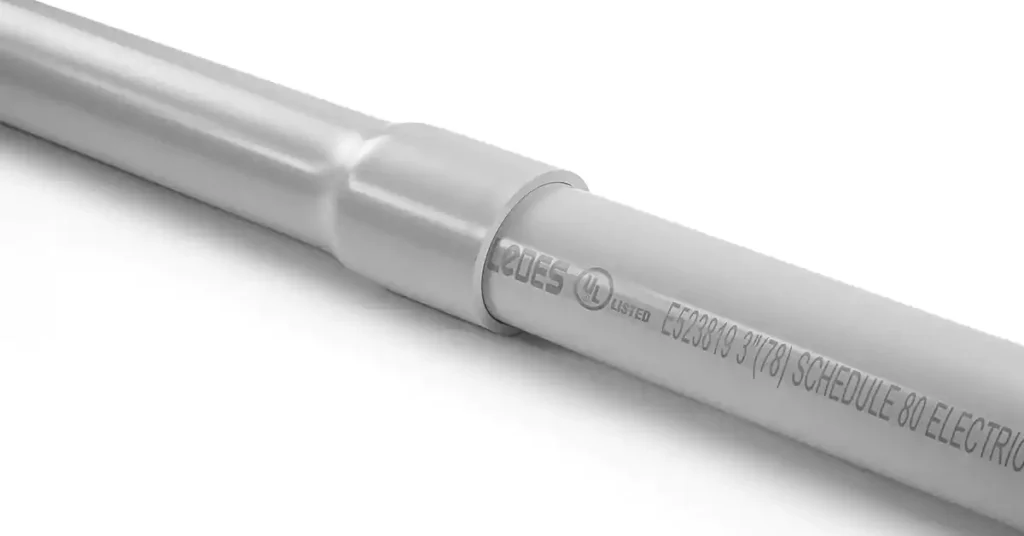
ASTM D1784 is the standard specification that covers the classification system and physical properties requirements for rigid PVC and CPVC compounds used in the production of pipes, conduits and fittings. It serves as the foundation for material selection, quality control, and performance evaluation in various applications.
The primary purpose of ASTM D1784 is to establish a uniform classification system for rigid PVC and CPVC compounds. This standard ensures that the materials used in manufacturing meet specific quality, strength, and durability requirements, enabling consistent performance across different applications.
ASTM D1784 classifies PVC and CPVC compounds based on their physical properties, including:
- Base resin
- Impact resistance (lzod)
- Tensile strength & Modulus of elasticity in tension
- Deflection temperature under load
- Entflammbarkeit
These properties are defined in Table 1 of the standard, where each class of material is represented by a unique cell classification code, such as 12454. This code sequentially represents the resin type, impact strength, tensile strength, modulus of elasticity, and heat deflection temperature rating.
PVC and CPVC compounds under ASTM D1784 typically consist of:
Base resin: At least 80% vinyl chloride (PVC) or chlorinated vinyl chloride (CPVC)
Lubricants: To aid in processing and prevent surface defects
Stabilizers: To enhance thermal and UV resistance
Fillers: Sometimes added to improve mechanical properties or reduce costs
ASTM D1784 specifies different material properties that must be met for a compound to qualify under the standard.
For PVC Compounds:
Impact Strength (Izod): ≥ 34.7 J/m (0.65 ft-lbf/in.) (ASTM D256)
Tensile Strength: ≥ 48.3 MPa (7000 psi) (ASTM D638)
Modulus of Elasticity in Tension: ≥ 2758 MPa (400,000 psi)
Heat Deflection Temperature (HDT): ≥ 70°C (158°F) under a load of 1.82 MPa (ASTM D648)
For CPVC Compounds:
Impact Strength (Izod): ≥ 34.7 J/m (0.65 ft-lbf/in.) (ASTM D256)
Tensile Strength: ≥ 48.3 MPa (7000 psi) (ASTM D638)
Modulus of Elasticity: ≥ 2758 MPa (400,000 psi) (ASTM D638)
Heat Deflection Temperature: ≥ 50°C (122°F) after annealing for 24 hours
Flame Resistance: Burning extent ≤ 25 mm, extinguishing within 10 seconds (ASTM D635)
To ensure proper handling and traceability, ASTM D1784 specifies that PVC/CPVC materials should be commercially packaged with detailed labeling, including:
Material name and grade
Manufacturer’s name
Batch and lot number
Quantity
Shipping information
Contract or order reference
Proper packaging and labeling help in maintaining product integrity and ensuring compliance with industry standards.
The compounds classified under ASTM D1784 are used in the manufacturing of various extruded and molded products, including:
Extruded pipes (for water supply, drainage, and industrial applications)
Injection-molded fittings (used for pressure and non-pressure piping systems)
Pressure-rated piping systems (requiring additional long-term stress considerations)
For high-temperature CPVC applications, Grade 10/11 is typically used due to its superior heat resistance and long-term performance in hot water or industrial chemical environments.
ASTM D1784 serves as the foundation for PVC and CPVC material classification, ensuring that products meet mechanical, thermal, and chemical performance requirements.
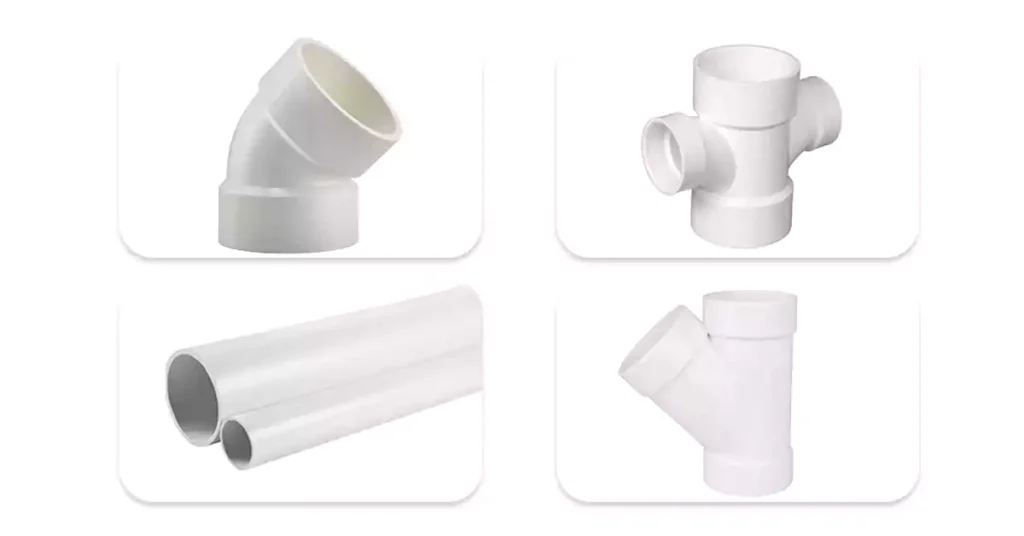
ASTM D2665 is a widely recognized standard that specifies the requirements for Poly(Vinyl Chloride) (PVC) plastic drain, waste, and vent (DWV) pipes and fittings. This standard ensures that PVC DWV piping systems meet stringent material, dimensional, and mechanical property requirements to ensure long-term performance, safety, and durability in sanitary drainage applications.
PVC pipes and fittings manufactured under ASTM D2665 are primarily used for gravity-fed sanitary drainage, waste disposal, and venting applications in both residential and commercial plumbing systems. The standard provides essential guidelines for material composition, physical properties, impact resistance, and pipe stiffness to ensure high reliability in DWV systems.
Measurement Method: All dimensions, including outside diameter (OD), wall thickness, and length, must be determined following ASTM D2122.
Standard Lengths: Pipes are typically manufactured in lengths of 10 ft (3.05 m) and 20 ft (6.10 m), with an allowable tolerance of +1.0 in.
Outside Diameter and Wall Thickness: The OD and wall thickness must conform to the specifications detailed in Table 2 of ASTM D2665.
Armaturen: Drain, waste, and vent fittings should comply with ASTM F1866 to ensure proper fit and function within the piping system.
Pipe stiffness (PS) is a key performance criterion for PVC DWV piping systems, ensuring resistance to deformation under load. The pipe stiffness is determined using ASTM D2412, which measures the pipe’s ability to withstand 5% deflection without structural failure.
Minimum stiffness values for different pipe diameters are provided in Table 3 of ASTM D2665, ensuring structural integrity in buried and above-ground applications.
Testing Method: Impact resistance is determined using ASTM D2444, which involves a falling weight impact test (Tup C).
Annahmekriterien: Typically, 9 out of 10 specimens must pass without showing signs of cracking or splitting.
Fittings Impact Strength: Individual fittings, especially at parting lines, must withstand a minimum force of 750 lbf/ft (11 kN/m) without any visible fractures, as specified in section 6.3.2 of ASTM D2665.
ASTM D2665 encompasses various fittings essential for DWV systems, including:
Standard Fittings: Elbows, tees, wyes, and couplings that conform to ASTM D3311, ensuring standardized dimensions and configurations.
Short-Length Pipes: Short sections of DWV pipes that comply with ASTM F2135, suitable for specific installation requirements.
Threaded Fittings: Components with threads that must meet the specifications of ASTM F1498 to ensure proper sealing and mechanical strength.
To ensure consistent product quality, manufacturers must perform regular testing and adhere to the specified requirements. This includes calculating the Lower Confidence Limit (LCL) for pipe stiffness to ensure that 99% of all manufactured pipes meet or exceed the required stiffness values, providing additional quality assurance and reliability.
By adhering to ASTM D2665, manufacturers and plumbing professionals can ensure that PVC DWV piping systems are reliable, durable, and suitable for their intended applications, thereby safeguarding public health and infrastructure integrity.
ASTM E662-17 is a standard test method designed to evaluate the smoke generation and optical density characteristics of solid materials under both pyrolytic (non-combustion) and flaming (combustion) conditions. The main objective is to quantify how much the material attenuates light by producing smoke, which is reported as a specific optical density (Ds).
The primary objective of ASTM E662-17 is to measure how much smoke a material generates under specified exposure conditions. This is crucial for evaluating materials in environments where smoke density can impact visibility and evacuation during a fire. However, it is important to note that:
- The test results provide specific optical density (Ds) values that are applicable only to the tested sample in its given form and thickness.
- The method does not account for toxicological effects of the smoke or its physiological impact on human vision.
- The test does not predict smoke behavior in real-world fire conditions, where factors such as ventilation, combustion dynamics, and multi-material interactions influence smoke production.
The test is conducted inside a closed smoke density chamber where a material sample is exposed to a controlled heat source. Smoke accumulation is measured using a photometric system that tracks light attenuation over time, allowing for the calculation of the specific optical density (Ds). The test includes two conditions:
The sample is exposed to a 2.5 W/cm² radiant heat flux without direct flame application.
Dieser Zustand simuliert Szenarien, in denen Materialien aufgrund von Hitzeeinwirkung ohne Zündung Rauch erzeugen.
Es wird der gleiche Wärmestrom von 2,5 W/cm² angewendet, allerdings zusätzlich mit einem Sechsrohrbrenner, der eine direkte Flamme erzeugt, um das Material zu entzünden.
Mit diesem Aufbau wird die Rauchentwicklung bei aktiver Verbrennung des Materials ausgewertet.
Der unter beiden Bedingungen erzeugte Rauch wird mithilfe eines photometrischen Systems analysiert, das die Lichtdurchlässigkeit durch die Kammer misst. Aus der Verringerung der Lichtintensität lässt sich die spezifische optische Dichte berechnen.
Die spezifische optische Dichte (Ds) wird mit folgender Formel bestimmt:
Ds = G ⋅ {log (100/T) + F}
Wo:
Ds = Spezifische optische Dichte
G = Geometrischer Faktor (typischerweise 132)
T = Prozentsatz des durch den Rauch durchgelassenen Lichts
F = Ein Korrekturfaktor, der die anfänglichen Lichtdurchlässigkeitsbedingungen berücksichtigt
Diese Gleichung drückt aus, wie stark der Rauch die Sicht verringert, indem sie die logarithmische Abnahme der Lichtdurchlässigkeit misst.
- Die Ergebnisse werden als spezifische optische Dichtewerte (Ds) ausgedrückt, die die Rauchkonzentration in der Kammer angeben.
- Die Proben müssen eine einheitliche Zusammensetzung aufweisen und ihre Dicke sollte 1 Zoll (25,4 mm) nicht überschreiten.
- Wenn eine Probe eine Selbstentzündung oder ein unerwartetes Verbrennungsverhalten aufweist, sind zusätzliche Tests erforderlich, um die Datenzuverlässigkeit sicherzustellen.
- Die erhaltenen Werte stellen keine inhärenten Eigenschaften des Materials dar und können unter verschiedenen Brandbedingungen variieren.
ASTM E662-17 spielt eine entscheidende Rolle bei der Beurteilung von Materialien für Anwendungen, bei denen Rauchentwicklung ein Problem darstellt, wie beispielsweise:
- Baumaterialien (z. B. Wandpaneele, Fußböden, Isolierung).
- Elektrische Leitungs- und Rohrsysteme, bei denen die Rauchdichte die Einhaltung der Brandschutzbestimmungen beeinträchtigen kann.
- Transportsektoren, einschließlich der Flugzeug-, Eisenbahn- und Automobilindustrie, in denen eine durch Rauch verringerte Sicht die Sicherheit der Passagiere beeinträchtigen kann.
Durch die Einhaltung dieser Norm können Hersteller, Designer und Aufsichtsbehörden Materialien anhand ihres Rauchentwicklungspotenzials besser bewerten und vergleichen, was zu einer sichereren Produktentwicklung und verbesserten Brandschutzstandards führt.
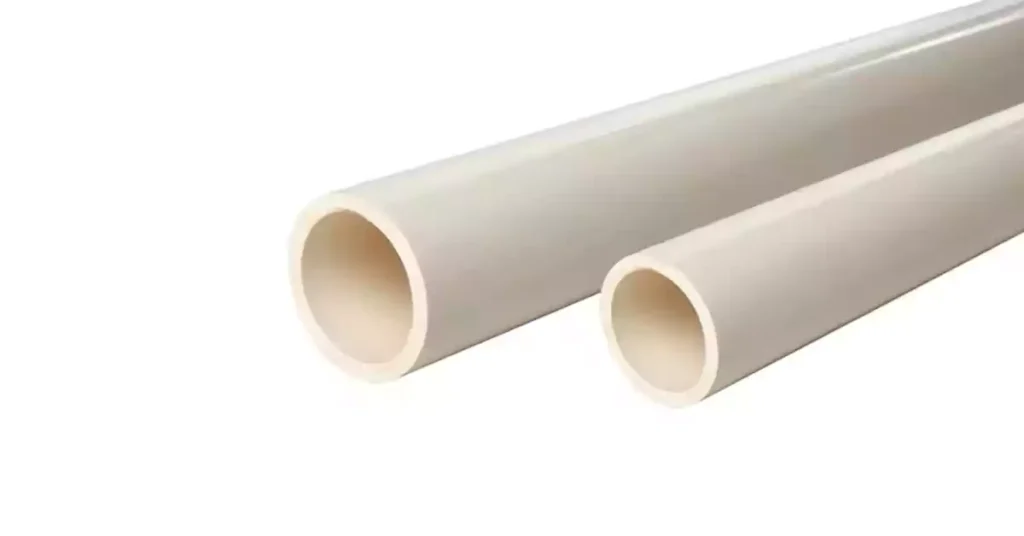
ASTM F442/F442M-23 ist eine Standardspezifikation, die die Anforderungen an Kunststoffrohre aus chloriertem Polyvinylchlorid (CPVC) für den Einsatz in Druckwasserverteilungssystemen definiert. Diese Norm legt Materialeigenschaften, Abmessungen, Klassifizierung und Leistungskriterien fest, um die strukturelle Integrität und langfristige Zuverlässigkeit von CPVC-Rohren unter unterschiedlichen Temperatur- und Druckbedingungen zu gewährleisten.
Das Hauptziel von ASTM F442/F442M-23 besteht darin, die Abmessungen, Materialeigenschaften und Druckstufen von CPVC-Rohren für die Wasserverteilung festzulegen. Es stellt sicher, dass CPVC-Rohre nach einheitlichen Qualitätsstandards hinsichtlich hydrostatischer Festigkeit, Haltbarkeit und chemischer Beständigkeit hergestellt werden und sich somit für Warm- und Kaltwasseranwendungen in Wohn-, Gewerbe- und Industrieumgebungen eignen.
Rohre gemäß ASTM F442/F442M-23 werden aus chloriertem Polyvinylchlorid (CPVC) hergestellt und sind so formuliert, dass sie im Vergleich zu herkömmlichen PVC-Rohren eine verbesserte Temperaturbeständigkeit, Korrosionsbeständigkeit und chemische Verträglichkeit bieten.
Der Standard klassifiziert CPVC-Rohre anhand von zwei wichtigen Bewertungssystemen:
- Standard-Dimensionsverhältnis (SDR-PR-System): Die Kategorisierung von Rohren erfolgt auf Grundlage eines festen Verhältnisses von Außendurchmesser zu Wandstärke (SDR) und einer entsprechenden Druckstufe (PR).
- Klassensystem: Rohren wird eine bestimmte Druckklasse zugewiesen, die ihre Fähigkeit angibt, dem Innendruck bei einer bestimmten Temperatur standzuhalten.
Deckt sechs Standarddimensionsverhältnisse (SDR) ab:
SZR: 11, 13,5, 17, 21, 26 und 32,5.
Der SDR, berechnet als Verhältnis von Außendurchmesser zu minimaler Wandstärke (gerundet auf 0,5), korreliert direkt mit den Druckstufen und ermöglicht so eine einheitliche Leistung über alle Nennweiten hinweg. Niedrigere SDR-Werte (z. B. SDR11) weisen auf dickere Wände für Anwendungen mit höherem Druck hin, während höhere SDR-Werte (z. B. SDR32,5) für Umgebungen mit niedrigerem Druck geeignet sind. Hydrostatische Auslegungsspannungen, abgeleitet aus Langzeittests, klassifizieren Rohre zusätzlich nach ihrer Druckbelastbarkeit bei 23 °C und 82 °C.
Die in diesen Rohren verwendeten CPVC-Verbindungen müssen der ASTM D1784 entsprechen, um sicherzustellen, dass das Material strenge mechanische und physikalische Eigenschaften aufweist. Zusätzlich werden die hydrostatischen Auslegungsgrundlagen (HDB) und die hydrostatische Auslegungsspannung (HDS) gemäß ASTM D2837 bestimmt. Dabei gelten folgende Schlüsseleigenschaften:
HDB bei 73 °F (23 °C): 4000 psi (28 MPa)
HDB bei 180 °F (82 °C): 1000 psi (7,0 MPa) oder 1250 psi (8,6 MPa)
Jedes CPVC-Rohr ist mit einem Materialcode gekennzeichnet, der ASTM-Typ und -Klasse sowie die Spannungswerte bei 23 °C und 82 °C (180 °F) in Einheiten von 0,7 MPa (100 psi) enthält. Der vollständige Materialcode besteht aus vier Buchstaben und sechs Ziffern zur korrekten Identifizierung und Klassifizierung.
Materialbezeichnungscodes (z. B. CPVC 4120-05 oder CPVC 4120-06) spiegeln die Konstruktionsspannungen bei beiden Temperaturen wider.
Das Nacharbeitsmaterial muss sauber sein und alle Spezifikationsanforderungen erfüllen.
Der Standard schreibt strenge Tests zur Bestätigung der Rohrqualität vor:
- Maßtoleranzen:
Außendurchmesser (OD): Entspricht Tabelle 1 (gemäß ASTM D2122), mit Toleranzen für Unrundheit, die vor dem Versand gelten.
Wandstärke: Entspricht Tabelle 2 (gemäß ASTM D2122), mit einer maximalen Dickenabweichung von 12%.
- Druckprüfung:
Dauerdrucktest: Sechs Proben halten 1.000 Stunden Druck stand. Das Versagen von zwei Proben führt zur Ablehnung.
Berstdruckprüfung: Fünf Proben werden innerhalb von 60–70 Sekunden unter Einhaltung von Mindestschwellenwerten bis zum Versagen unter Druck gesetzt.
Beschleunigter Regressionstest (optional): Als Alternative zu Dauer-/Bersttests verwendet diese Methode eine Regressionsanalyse (gemäß ASTM D2837), um die hydrostatische Festigkeit für 100.000 Stunden zu prognostizieren.
Die untere Konfidenzgrenze (LCL) überschreitet 15% des extrapolierten LTHS.
Statistische Parameter (M ≤ 0 oder Steigung b ≥ 0) weisen auf unzuverlässige Projektionen hin.
Abflachungstest: Drei auf 40 % ihres Durchmessers komprimierte Proben dürfen keine Risse oder Brüche aufweisen.
Zu den lesbaren, dauerhaften Markierungen im Abstand von ≤ 1,5 m (5 Fuß) gehören:
Nennweite des Rohrs (z. B. NPS 2 oder NPS 50).
Materialcode (z. B. CPVC4120-05).
SDR (z. B. SDR13,5).
Druckwerte bei 73 °F und 180 °F (z. B. „400 psi bei 73 °F, 100 psi bei 180 °F“).
ASTM-Bezeichnung (F442, F442M oder F442/F442M).
Name/Marke des Herstellers und Produktionscode.
Trinkwasserleitungen: Siegel/Kennzeichen des Prüflabors.
CPVC-Rohre müssen strenge Leistungs- und Qualitätskriterien gemäß ASTM F442/F442M-23 erfüllen. Dazu gehört die Einhaltung von:
- Mindestanforderungen an die hydrostatische Auslegungsspannung, um eine langfristige Druckbeständigkeit zu gewährleisten.
- Wandstärke und Maßtoleranzen für Gleichmäßigkeit und Zuverlässigkeit.
- Materialreinheit und -konsistenz garantieren hohe Leistung bei anspruchsvollen Anwendungen.
Hersteller, die CPVC-Rohre nach dieser Norm produzieren, müssen regelmäßige Qualitätskontrollen durchführen, um die Konformität aufrechtzuerhalten und sicherzustellen, dass jede Charge den angegebenen Standards entspricht.
Rohre zur Ableitung von Verbrennungsgasen sind von der Norm ausdrücklich ausgeschlossen. Der Schwerpunkt liegt auf Wasserversorgungssystemen. CPVC eignet sich aufgrund seiner Korrosionsbeständigkeit, thermischen Stabilität und Wirtschaftlichkeit ideal für den Einsatz im privaten, gewerblichen und industriellen Bereich.
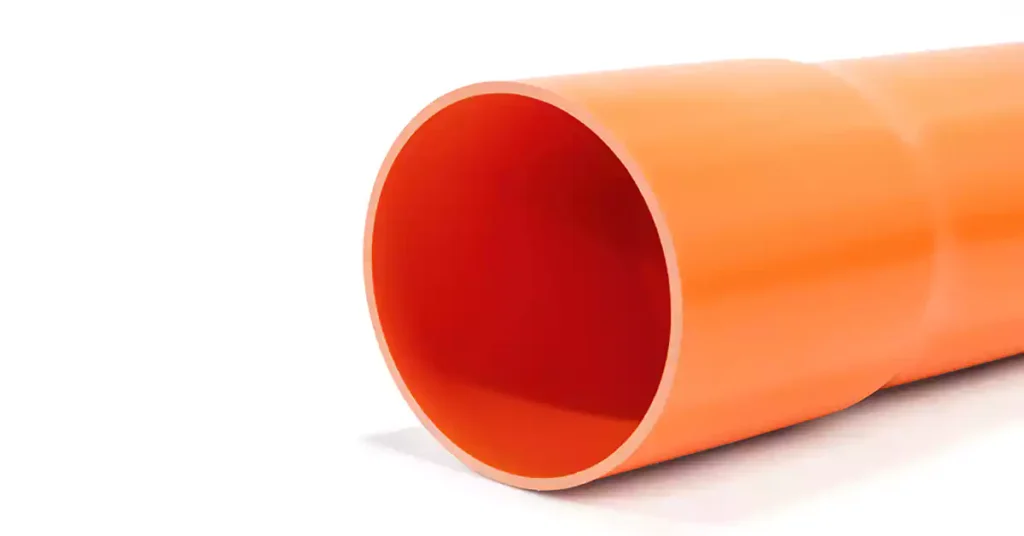
ASTM F512-12 ist eine Standardspezifikation, die die Anforderungen an glattwandige Polyvinylchlorid-(PVC)-Rohre und -Armaturen für den unterirdischen Einsatz, vorwiegend in Elektro- und Kommunikationssystemen, definiert. Die Norm unterteilt Rohre anhand ihrer vorgesehenen Installationsmethode in zwei Haupttypen: Ummantelte Erdverlegung (EB), die eine Betonummantelung zur strukturellen Unterstützung erfordert, und Direkt vergrabene Leitungen (DB), die ohne zusätzliche Verstärkung direkt im Boden vergraben werden können. Der Hauptzweck dieser Norm besteht darin, die Einheitlichkeit der Leistung, Haltbarkeit und Kompatibilität der Leitungen sicherzustellen und gleichzeitig den Schutz von Elektro- und Kommunikationskabeln in unterirdischen Umgebungen zu gewährleisten.
Die unter ASTM F512-12 beschriebenen Leitungen und Armaturen werden aus Hart-Polyvinylchlorid (PVC) hergestellt und entsprechen den Materialspezifikationen der ASTM D1784. Die zulässigen PVC-Zellklassifizierungen umfassen 12254-A/B und 12164-B5 und gewährleisten hohe Haltbarkeit, mechanische Festigkeit und Widerstandsfähigkeit gegen Umwelteinflüsse. Darüber hinaus ermöglicht die Spezifikation sowohl einwandige Leitungen als auch coextrudierte Leitungen mit Wabenkern. Die Leitungsverbindungen sind entweder als integrierte Glocke oder als separate Kupplung erhältlich.
ASTM F512-12 klassifiziert Leitungen basierend auf der Rohrsteifigkeit und der beabsichtigten Verlegungsmethode in fünf Typen:
EB-20 – Zum Einbetonieren konzipiert.
EB-35 – Entwickelt für die Einbettung in Beton mit höherer Steifigkeit als EB-20.
DB-60 – Konzipiert für die direkte Erdverlegung ohne Betonummantelung.
DB-100 – Für die direkte Verlegung im Erdreich konzipiert, bietet eine höhere Steifigkeit als DB-60.
DB-120 – Für die direkte Erdverlegung konzipiert, bietet es die höchste Steifigkeit unter den DB-Rohren.
Darüber hinaus umfasst die Spezifikation geformte und gefertigte Armaturen, die mit allen oben aufgeführten Leitungstypen kompatibel sind.
Die Norm legt die Abmessungen und Toleranzen von Leitungen fest, einschließlich Wandstärke, Muffentiefe und Längenanforderungen. Diese Abmessungen werden gemäß den Prüfmethoden ASTM D2122 ermittelt.
- Sofern zwischen Hersteller und Käufer nichts anderes vereinbart wurde, werden die Leitungslängen normalerweise in Abschnitten von 20 Fuß (6,1 m) oder 25 Fuß (7,6 m) geliefert.
- Die Abmessungen der integrierten Glocken und Steckdosen folgen zwei primären Montagesystemen:
- Presspassungssystem gemäß ASTM D2466-Spezifikationen.
- Clearance-Fit-System mit Toleranzen, die in ASTM F512-12 definiert sind.

Um die Einhaltung der Leistungsanforderungen sicherzustellen, werden Leitungen und Armaturen einer Reihe standardisierter Tests unterzogen:
Validiert die Integrität der Fusion, indem die Proben Aceton ausgesetzt werden, und stellt sicher, dass keine Oberflächenverschlechterung oder Laminierungen auftreten.
Misst die Steifigkeit des Rohrs bei einer Auslenkung von 5%. Die erforderlichen Mindestwerte für die Steifigkeit sind:
EB-20: ≥ 20 psi
EB-35: ≥ 35 psi
DB-60: ≥ 60 psi
DB-100: ≥ 100 psi
DB-120: ≥ 120 psi
Bewertet die Widerstandsfähigkeit des Rohrs gegenüber mechanischen Einwirkungen mit Schlaghämmern des Typs A oder B. Rohre müssen den Schlagtest mit einer akzeptablen Mindestdurchfallquote bestehen (z. B. müssen 17 von 20 Proben die Anforderungen erfüllen).
Anforderungen: Bewertet die Zähigkeit bei 0 °C (32 °F) mit einem Hammer Typ A oder B. Beispielsweise gilt eine Charge als bestanden, wenn 17 von 20 Proben der angegebenen Schlagenergie standhalten, ohne zu reißen.
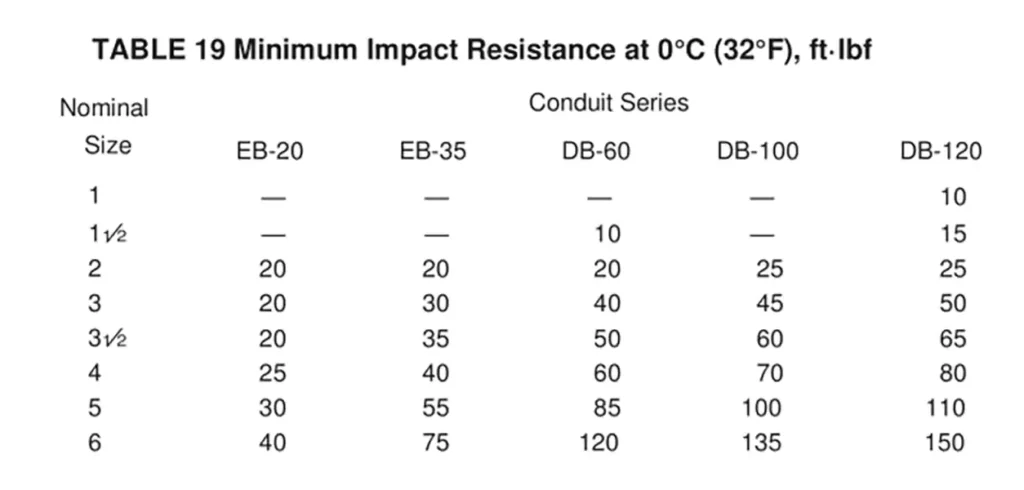
Gemäß ASTM F512-12 hergestellte Leitungen und Armaturen müssen die folgenden Qualitäts- und Leistungskriterien erfüllen:
Homogenität: Das Material muss frei von sichtbaren Rissen, Löchern, Fremdeinschlüssen oder anderen Mängeln sein, die die Leistung beeinträchtigen könnten.
Gleichmäßigkeit: Um die Produktintegrität zu wahren, sollten die Leitungen eine einheitliche Farbe, Opazität, Dichte und mechanische Eigenschaften aufweisen.
Einhaltung der Wandstärke: Die Wandstärke von integrierten Glocken und Schornsteinen muss den Mindestanforderungen entsprechen, um die strukturelle Zuverlässigkeit zu gewährleisten.
Um Rückverfolgbarkeit und Konformität zu gewährleisten, müssen Leitungen und Armaturen im Abstand von höchstens 1,5 m (5 Fuß) deutlich mit wichtigen Informationen gekennzeichnet sein. Die Kennzeichnungen umfassen:
Name oder Marke des Herstellers
PVC-Zellklassifizierung (z. B. PVC 12254-A, PVC 12254-B, PVC 12164-B)
Leitungsgröße und -typ (z. B. DB-60, EB-35)
Mindestwandstärke
Kontrollnummer oder Chargencode
ASTM designation (ASTM F512 for single extrusion; ASTM F512 COEX for coextruded products)
Additionally, sweeps and bends should be marked with their bend radius and angle (e.g., 18″ R – 30°), while fittings should be labeled with size, material type (PVC), and the ASTM F512 designation. If space constraints prevent direct marking on fittings, the required information should be included on the packaging.
ASTM F512-12 is pivotal in underground infrastructure for electrical and communication networks, offering solutions that balance flexibility, strength, and corrosion resistance. Its dual focus on concrete-encased and direct-burial applications ensures adaptability to diverse installation environments, from urban utility corridors to industrial sites. By enforcing stringent material and testing protocols, the standard mitigates risks of premature failure, ensuring conduits meet the demands of modern buried infrastructure systems.
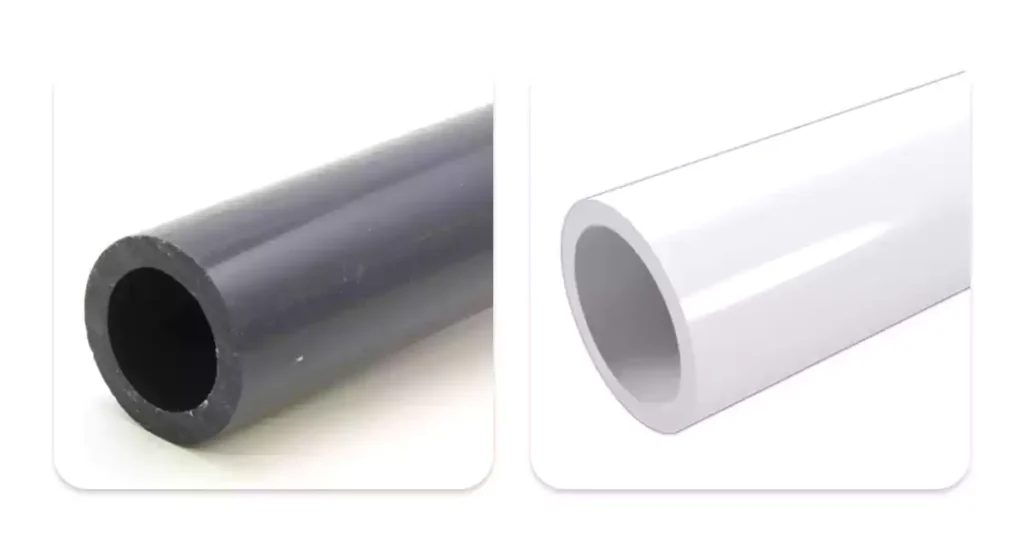
ASTM D1785-21 is a standard specification that defines the requirements for poly(vinyl chloride) (PVC) plastic pipes manufactured in Schedule 40, 80, and 120 wall thicknesses. This specification applies to pressure-rated pipes intended primarily for the conveyance of fluids, including potable water, in various plumbing and industrial applications. The standard provides guidelines for material composition, classification, dimensional tolerances, hydrostatic pressure ratings, and performance testing to ensure the quality, safety, and durability of PVC pipes used in fluid transportation systems.
This specification establishes six types/grades of PVC pipes, categorized based on hydrostatic design stress and long-term performance testing. It also aligns with ASTM D1784, which sets the material classification requirements for PVC compounds used in the manufacturing of these pipes.
ASTM D1785-21 classifies PVC pipes based on their type, grade, and hydrostatic design stress, ensuring consistent performance across different applications. This specification covers pipes produced in Schedule 40, 80, and 120 wall thicknesses, with each pipe clearly marked according to one of six designated type/grade/stress classifications.
Schedule 40: Standard-weight pipe for moderate-pressure applications.
Schedule 80: Heavy-duty pipe for higher-pressure systems.
Schedule 120: Extra-heavy pipe for specialized high-stress environments.
A key aspect of this classification is the hydrostatic design stress (HDS), which determines the long-term pressure-bearing capability of the pipe. These stresses are established through rigorous long-term testing, ensuring that the pipes can withstand sustained internal pressures without failure. The classification framework helps in selecting the appropriate pipe for different pressure applications, particularly in water distribution and industrial systems.
ASTM D1785-21 specifies that PVC pipes must be made from poly(vinyl chloride) (PVC) plastics with well-defined physical and chemical properties. The materials used must meet the standards set in ASTM D1784, specifically PVC 12454 or PVC 14333, ensuring durability, strength, and chemical resistance.
For potable water applications, the pipe must be tested and certified to meet NSF/ANSI Standard 14, ensuring it is safe for drinking water use. Pipes that pass this certification must display the appropriate approval mark.
Manufacturers can also use clean rework PVC material, but only from their own production process, and the final product must fully comply with ASTM D1785-21 requirements. This ensures consistent quality and performance across all PVC pipes.
The dimensional and tolerance requirements for PVC pipes are specified in Tables 1 and 2 of the standard. These dimensions are verified according to ASTM D2122, ensuring compliance with strict manufacturing tolerances. Key aspects include:
Outer diameter, wall thickness, and tolerances – ensuring pipes meet the required size specifications.
Out-of-roundness tolerances – applicable before shipment to ensure proper fit during installation.
To ensure durability and safety, ASTM D1785-21 mandates several critical tests for PVC pipes:
Pipes must withstand hydrostatic pressure for 1,000 hours at their designated stress level without failure (such as bursting or leaking).
Pipes must endure a short-term hydrostatic pressure test at four times the rated pressure for 60-70 seconds without failure.
Pipe specimens (minimum 2 inches long) are compressed between two parallel plates until they reach 40% of their original diameter or until the walls touch.
The specimen must not crack, split, or break under this pressure.
- Tests are conducted in a controlled laboratory environment at 73°F ± 4°F (23°C ± 2°C) with 50% ± 10% relative humidity, unless otherwise specified.
- For impact testing, specimens are conditioned at 32-35°F (0-1.6°C) for at least 30 minutes before testing.
These stringent testing procedures ensure that PVC pipes meet performance expectations for high-pressure applications.
To ensure traceability and compliance, ASTM D1785-21 requires all pipes to be clearly marked with the following information at intervals not exceeding 5 feet (1.5 meters):
Nominal pipe size (e.g., 2 inches (50 mm))
PVC material designation code (e.g., PVC 1120)
Schedule and pressure rating (e.g., Schedule 40, 200 psi)
ASTM designation and year (e.g., ASTM D1785-21)
Name oder Marke des Herstellers
Production code (identifying date, shift, plant, and extruder used in manufacturing)
Marking for potable water use (if applicable)
Manufacturers must ensure that markings remain legible after installation and inspection.
PVC pipes are regulated by multiple ASTM standards, depending on their intended application. The table below summarizes key differences:
6 Different ASTM Standard Comparing Chart
Normen | Core Content | Key Tests | Applicable Pipe Types | Special Requirements |
ASTM D1784-20/11 | PVC and CPVC material classification | Izod impact, tensile strength, heat deflection | Extruded/injection-molded pipes & fittings. | Pressure pipes require HDB evaluation |
ASTM D1785-21 | PVC pressure pipes for pressurized water systems | Sustained pressure, burst pressure, flattening test | Schedule 40, 80, 120 pipes | Production code traceability; integral bell joints. |
ASTM D2665 | DWV (Drain, Waste, and Vent) pipe performance | Pipe stiffness, impact test | DWV pipes, elbows, tees | Threads must meet ASTM F1498 |
ASTM F442/F442M -23 | CPVC pressure pipe | Sustained burst /pressure, flattening test | SDR series pipes | Prohibits pneumatic testing |
ASTM E662-17 | Smoke density testing | Optical attenuation | Solid materials | Sample thickness ≤ 1 inch |
ASTM E512-12 | Smooth-wall PVC conduit for underground installation | Acetone immersion, Pipe stiffness, Impact | EB/DB conduit types | Material must meet 12254-A/B grade |
In summary, ASTM standards for PVC and CPVC pipes, all play a critical role in ensuring the reliability, safety, and performance of these piping systems across a variety of applications. From defining the material specifications and classifications to setting rigorous testing requirements, these standards ensure that PVC and CPVC pipes meet the necessary strength, durability, and chemical resistance criteria for use in water distribution, electrical conduit, and industrial systems.
By adhering to these established guidelines, manufacturers can produce pipes that perform consistently under pressure and environmental stress, while also complying with important safety and health regulations, such as those for potable water. The comprehensive requirements for materials, manufacturing processes, and pressure ratings outlined in these standards provide a clear framework for achieving high-quality pipe products.
Ultimately, understanding and following ASTM standards is essential for anyone involved in the design, manufacturing, and installation of PVC and CPVC piping systems, ensuring that the final products meet the highest performance and safety standards.
Contact our expert today if you still have any questions about ASTM standards or related; we will reply to you within 24 hours.
ASTM D1784 – 11: Standard Specification for Rigid Poly(Vinyl Chloride) (PVC) Compounds and
Chlorinated Poly(Vinyl Chloride) (CPVC) Compounds
ASTM D2665: Standard Specification for Poly(Vinyl Chloride) (PVC) Plastic Drain, Waste, and Vent
ASTM E662 – 17a: Standard Test Method for Specific Optical Density of Smoke Generated by Solid
ASTM F512 – 12: Standard Specification for Smooth-Wall Poly(Vinyl Chloride) (PVC) Conduit and



